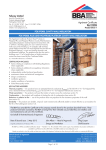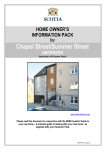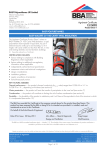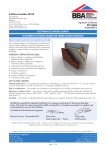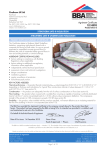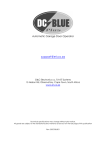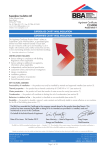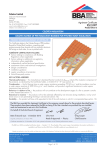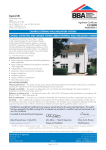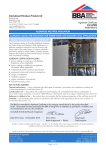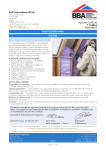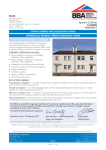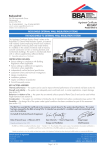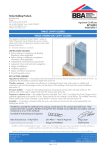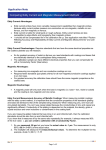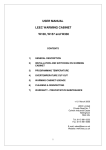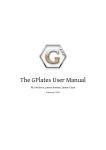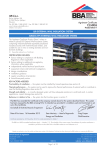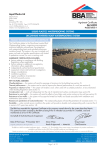Download Tebway Limited POLYPEARL CAVITY WALL INSULATION
Transcript
APPROVAL INSPECTION TESTING CERTIFICATION Tebway Limited Unit 20 Churchill Park Colwick Industrial Estate Nottingham NG4 2HF Tel: 0115 987 5787 Fax: 0115 987 5786 TECHNICAL APPROVALS FOR CONSTRUCTION Agrément Certificate 96/3228 e-mail: [email protected] website: www.polypearl.co.uk Product Sheet 1 POLYPEARL CAVITY WALL INSULATION POLYPEARL PLUS AND POLYPEARL PLATINUM CAVITY WALL INSULATION PRODUCT SCOPE AND SUMMARY OF CERTIFICATE This Certificate relates to Polypearl Plus and Polypearl Platinum Cavity Wall Insulation, expanded polystyrene materials injected in bead form, with or without a binding agent, for use in buildings up to and including 12 m in height, in new and existing domestic and non-domestic buildings. The products may also be used in buildings over 12 m in height where a height restriction waiver has been issued. AGRÉMENT CERTIFICATION INCLUDES: • factors relating to compliance with Building Regulations where applicable • factors relating to additional non-regulatory information where applicable • independently verified technical specification • assessment criteria and technical investigations • design considerations • installation guidance • regular surveillance of production • formal three-yearly review. KEY FACTORS ASSESSED Thermal properties — the products have thermal conductivities of 0.037 W·m–1·K–1 for Polypearl Plus and 0.033 W·m–1·K–1 for Polypearl Platinum (see section 5). Liquid water penetration — the products will resist the transfer of water across the cavity (see section 6). Condensation — walls will limit the risk of condensation provided the conditions stated are met (see section 7). Behaviour in relation to fire — use of the products does not prejudice the fire resistance properties of the wall (see section 8). Durability — the products are durable, rot-proof, water resistant and sufficiently stable to remain effective as an insulation for the life of the building (see section 11). The BBA has awarded this Agrément Certificate to the company named above for the products described herein. These products have been assessed by the BBA as being fit for their intended use provided they are installed, used and maintained as set out in this Certificate. On behalf of the British Board of Agrément Date of First issue: 24 November 2010 Simon Wroe Greg Cooper Originally certificated on 27 February 1996 Head of Approvals — Physics Chief Executive The BBA is a UKAS accredited certification body — Number 113. The schedule of the current scope of accreditation for product certification is available in pdf format via the UKAS link on the BBA website at www.bbacerts.co.uk Readers are advised to check the validity and latest issue number of this Agrément Certificate by either referring to the BBA website or contacting the BBA direct. British Board of Agrément Bucknalls Lane Garston, Watford Herts WD25 9BA ©2010 Page 1 of 12 tel: 01923 665300 fax: 01923 665301 e-mail: [email protected] website: www.bbacerts.co.uk Regulations In the opinion of the BBA, Polypearl Plus and Polypearl Platinum Cavity Wall Insulation, if used in accordance with the provisions of this Certificate, will meet or contribute to meeting the relevant requirements of the following Building Regulations: The Building Regulations 2010 (England and Wales) Requirement: C2(a) Resistance to moisture Comment: The products do not absorb water by capillary action and, therefore, may be used in situations where they bridge the dpc’s of the inner and outer leaves. See section 6.2 of this Certificate. Requirement: C2(b) Resistance to moisture Comment: Tests by the BBA indicate that a wall incorporating these products can resist rain penetration and satisfy this Requirement. See sections 3.5, 3.7 and 6.3 of this Certificate. Requirement: C2(c) Resistance to moisture Comment: The products can contribute to satisfying the Condensation Requirement. See sections 7.1 and 7.3 of this Certificate. Requirement: L1(a)(i) Conservation of fuel and power Comment: The products can meet or contribute to meeting this Requirement. See sections 5.2 to 5.3 of this Certificate. Requirement: Regulation 7 Materials and workmanship Comment: The products are acceptable materials. See section 11.1 of this Certificate. The Building (Scotland) Regulations 2004 (as amended) Regulation: 8(1) Regulation: Standard: 9 2.6 3.4 3.10 3.15 Condensation The products can contribute to satisfying this Standard, with reference to clauses 3.15.1(1)(2), 3.15.4(1)(2) and 3.15.5(1)(2). See sections 7.2 and 7.3 of this Certificate. Comment: Standard: Standard: Precipitation The products will satisfy this Standard, with reference to clause 3.10.1(1) provided they comply with the conditions set out in sections 3.5 and 3.7 of this Certificate. See also section 6.3 of this Certificate. Comment: Standard: Moisture from the ground The products can contribute to a construction satisfying this Standard, with reference to clause 3.4.1(1)(2). The products can be used in situations where they bridge the dpc’s of the inner and outer leaves. See section 6.2 of this Certificate. Comment: Standard: Building standards – construction Spread to neighbouring buildings The products are not non-combustible but may be used in walls of buildings in accordance with the exceptions permitted in this Standard, with reference to clauses 2.6.5(1) and 2.6.6(2). See section 8.5 of this Certificate. Comment: Standard: Fitness and durability of materials and workmanship The products can contribute to a construction satisfying this Regulation. See section 11.1 and the Installation part of this Certificate. Comment: 6.1(b) 6.2 Carbon dioxide emissions Building insulation envelope These products will satisfy or contribute to satisfying these Standards, with reference to clause 6.2.1(1)(2). See sections 5.2 to 5.3 of this Certificate. Comment: (1) Technical Handbook (Domestic). (2) Technical Handbook (Non-Domestic). The Building Regulations (Northern Ireland) 2000 (as amended) Regulation: B2 Fitness of materials and workmanship Comment: Regulation: C4(a) Resistance to ground moisture The products are acceptable materials. See section 11.1 of this Certificate. The products do not absorb water by capillary action and, therefore, may be used in situations where they bridge the dpc’s of the inner and outer leaves. See sections 6.2 of this Certificate. Comment: Regulation: C4(b) Resistance to ground moisture and weather Tests by the BBA indicate that a wall incorporating these products can satisfy this Regulation. See sections 3.5, 3.7 and 6.3 of this Certificate. Comment: Regulation: C5 Condensation Comment: Regulation: Regulation: F2(a)(i) F3(2) Conservation measures Target carbon dioxide Emissions Rate Comment: The products can contribute to satisfying this Regulation. See section 7.3 of this Certificate. The products can contribute to satisfying these Regulations. See sections 5.2 to 5.3 of this Certificate. Page 2 of 12 Construction (Design and Management) Regulations 2007 Construction (Design and Management) Regulations (Northern Ireland) 2007 Information in this Certificate may assist the client, CDM co-ordinator, designer and contractors to address their obligations under these Regulations. See section: 2 Delivery and site handling (2.1 and 2.3) of this Certificate. Non-regulatory Information NHBC Standards 2010 NHBC accepts the use of Polypearl Plus and Polypearl Platinum Cavity Wall Insulation, when installed and used in accordance with this Certificate, in relation to NHBC Standards, Chapter 6.1, External masonry walls. Technical Specification 1 Description 1.1 Polypearl Plus and Polypearl Platinum Cavity Wall Insulation are expanded polystyrene bead materials (white and grey respectively), for use as an insulation within the cavity of masonry brick and block cavity walls, supplied with or without a binding agent. The binding agent is used to adhere the beads together and provide long-term stability to the insulation. 1.2 The target installed mean density for these products with or without binding agent is as shown in Table 1. Table 1 Target mean density (1) Product Density (kg·m–3) Polypearl Plus with binding agent 12 or 14 Polypearl Platinum with binding agent 12 All grades without binding agent 15 (1) Local areas within the wall when sampled over an area of 0.5 m may have density variations of +2 kg·m–3 for the system using the binding agent, and +5 kg·m–3 for the system without the binding agent. 2 2 Delivery and site handling 2.1 The products are delivered to site in polythene sacks or bulk containers marked with the BBA identification mark incorporating the number of this Certificate. The material, which has an indefinite storage life, should be kept dry. 2.2 Quotations, tenders and invoices bear the BBA identification mark incorporating the number of this Certificate. 2.3 The water based binding agent is delivered to site in containers marked with the BBA identification mark incorporating the number of this Certificate. It must not be allowed to freeze. Assessment and Technical Investigations The following is a summary of the assessment and technical investigations carried out on Polypearl Plus and Polypearl Platinum Cavity Wall Insulation. Design Considerations 3 General 3.1 Polypearl Plus and Polypearl Platinum Cavity Wall Insulation are effective in reducing the thermal transmittance (U value) of external cavity walls, with masonry inner and outer leaves (where masonry includes clay and calcium silicate bricks, concrete blocks, natural and reconstituted stone blocks). It is essential that such walls are designed and constructed so as to incorporate the normal precautions to prevent moisture penetration. 3.2 This Certificate covers the use of the products in any exposure zone, subject to the following conditions taken from the BBA joint publication Cavity Insulation of Masonry Walls — Dampness Risks and how to Minimise Them being met. They are particularly important in areas subject to severe or very severe driving rain: • the cavity width must be a nominal minimum of 40 mm • walls must be in good state of repair and must show no evidence of frost damage • mortar joints must not show evidence of more than hairline cracking. Raked or recessed mortar joints should be avoided in high exposure areas. Page 3 of 12 Partial filling 3.3 Partial filling of the gable apex (ie limiting the fill to several brickwork courses above ceiling level) is permitted provided the top of the wall is protected by the roof and: • the roof void is not an occupied space • where the loft insulation is at ceiling level 3.4 Partial filling is also allowed: • when separately insulating semi-detached or terraced properties; the type of cavity barriers used for this purpose must be defined, see section 16.2 • up to the underside of a horizontal boundary, other than the roof, where that horizontal boundary is protected by a cavity tray or similar waterproof barrier • where filling is carried out above a horizontal boundary • when treating properties where the wall to be insulated is below a waterproof cladding (eg tile hung) and this cladding either extends up to the roof or is protected at the top by other means (eg window sills) • when treating areas of wall where access for drilling may be limited by features such as carports and conservatories as defined in section 17.5. Existing buildings 3.5 Existing buildings subject to the national Building Regulations and Standards should be suitable when assessed in accordance with BS 8208-1 : 1985. 3.6 The products may be installed only where there are no signs of dampness on the inner face of the cavity wall other than those caused solely by condensation. New buildings 3.7 New buildings subject to the national Building Regulations should be constructed in accordance with the relevant recommendations of: • BS EN 1996-1-1 : 2005, BS EN 1996-1-2 : 2005, BS EN 1996-2 : 2006 and BS EN 1996-3 : 2006 • BS 5628-3 : 2005, with particular reference to Clause 5.5 Exclusion of water • BS 8000-3 : 2001. 3.8 Where the products are to be installed, injection of the insulant material must be left until the cavity is sealed from the weather, ie the roof is in place and window and door openings are sealed. 3.9 Where applicable, construction should be in accordance with the relevant clauses of NHBC Standards. 3.10 Other new buildings not subject to any of the above should also be built in accordance with the standards identified in 3.7. 4 Practicability of installation Installation of the products is to be carried out by the Certificate holder, or by an installer approved by the BBA or Certificate holder. 5 Thermal properties 5.1 Calculations of the thermal transmittance (U value) of specific external wall constructions should be carried out in accordance with BS EN ISO 6946 : 2007 and BRE Report (BR 443 : 2006) Conventions for U-value calculations, using the insulations mean thermal conductivity (mean) in Table 2. Table 2 Thermal conductivities of the insulation EPS bead Thermal conductivity (W·m–1·K–1) Polypearl Plus 0.037 Polypearl Platinum 0.033 5.2 The U value of a typical brick and block cavity wall construction will depend on the cavity width and the insulating value of the internal block leaf and finish. Calculated U values for example constructions are given in Table 3 and mean design U values in Tables 4, 5 and 6. Page 4 of 12 Table 3 Example cavity wall U values (W·m–2·K–1) (1) Cavity width (mm) Construction 13 mm Dense plaster 100 mm Dense block(2) Plasterboard on dabs 100 mm AAC block(3) Polypearl Plus Polypearl Platinum Polypearl Plus Polypearl Platinum 75 0.41 0.37 0.32 0.29 100 0.32 0.29 0.26 0.24 125 0.26 0.24 0.22 0.20 (1) Assumes fixings correction Delta Uf <3% of nominal U value and 102 mm thick brick outer leaf. (2) Block and plaster thermal conductivity 1.13 W·m–1·K–1 and 0.57 W·m–1·K–1 respectively. (3) Block and mortar thermal conductivity 0.12 W·m–1·K–1 and 0.88 W·m–1·K–1 respectively. Table 4 Mean design wall U values — England and Wales (1) Construction U value W·m–2·K–1 Notional non-domestic building 0.26 Existing building – new and replaced wall 0.28 Dwelling new-build limit 0.30 Notional dwelling 0.35 Non-domestic new-build limit 0.35 Existing building — renovated or retained wall 0.55 (1) Flexible approaches on existing buildings are given in the Approved Documents. Table 5 Mean design wall U values — Scotland (1) Construction U value W·m–2·K–1 Notional dwelling 0.19 New dwelling simplified method 0.19 Conversion unheated building (into dwellings) 0.19 Extension to dwelling 0.19 Alterations and reconstructions to a dwelling 0.22 Stand alone building < 50 m2 to a dwelling 0.22 New non-dwellings limit for shell and fit out 0.23 New dwelling limit 0.25 Conversion of unheated building 0.25 Non-domestic extension, alterations and reconstructions 0.25 New non domestic limit 0.27 Conversion of heated building 0.30 Notional non-dwelling 0.30 (1) Flexible approaches on existing buildings are given in the Technical Handbooks. Table 6 Mean design wall U values – Northern Ireland (1) Element U value W·m–2·K–1 Existing building — new wall 0.30 Notional dwelling 0.35 Notional non-domestic building 0.35 Building new-build limit 0.35 Existing building – replaced wall 0.35 Existing building – renovated and retained wall 0.55 (1) Flexible approaches on existing buildings are given in the Technical Booklets. Page 5 of 12 Junctions 5.3 The product can maintain, or contribute to maintaining, continuity of thermal insulation at junctions between elements and openings. For Accredited Construction Details the corresponding psi values in BRE Information Paper IP1/06 Assessing the effects of thermal bridging at junctions and around openings, Table 3 may be used in carbon emission calculations in Scotland and Northern Ireland. Detailed guidance for other junctions and on limiting heat loss by air infiltration can be found in: England and Wales — Approved Documents to Part L and for new thermal elements to existing buildings, Accredited Construction Details (version 1.0). See also SAP 2009 Appendix K and the iSBEM User Manual for new-build Scotland — Accredited Construction Details (Scotland) Northern Ireland — Accredited Construction Details (version 1.0). 6 Liquid water penetration 6.1 The products will resist the transfer of water across the cavity. Water, which penetrates the outer leaf of the wall, will drain down the cavity face of the outer leaf. 6.2 Results of test data by the BBA demonstrate that when the products are used in situations where it bridges the dpc in walls, dampness from the ground does not pass through to the inner leaf. This is provided that the wall is detailed in accordance with the requirements and provisions of the national Building Regulations: England and Wales — Approved Document C2(a) Scotland — Mandatory Standard 3.4, clause 3.4.1(1)(2) (1) Technical Handbook (Domestic). (2) Technical Handbook (Non-Domestic). Northern Ireland — Technical Booklet C, Section 1.6. 6.3 Results of tests conducted by the BBA confirm that constructions built in accordance with BS 5628-3 : 2005, will resist the transfer of precipitation to the inner leaf and satisfy the national Building Regulations: England and Wales — Requirement C2(b) Scotland — Mandatory Standard 3.10, clause 3.10.1(1) (1) Technical Handbook (Domestic). Northern Ireland — Regulation C4. 7 Condensation Surface condensation 7.1 Walls will adequately limit the risk of surface condensation when the thermal transmittance (U value) does not exceed 0.7 W·m–2·K–1 at any point and the junctions with other elements are designed in accordance with the guidance referred to in section 5.3 of this Certificate. 7.2 Walls will limit the risk of surface condensation adequately when the thermal transmittance (U value) does not exceed 1.2 W·m–2·K–1 at any point. Guidance may be obtained from Section 8 of BS 5250 : 2002 and BRE Report (BR 262 : 2002) Thermal insulation: avoiding risks. Interstitial condensation 7.3 Walls will limit the risk of interstitial condensation adequately when they are designed and constructed in accordance with BS 5250 : 2002, Section 8 and Annex D. 7.4 The products are not water vapour barriers and will therefore allow the passage of water vapour. 8 Behaviour in relation to fire 8.1 The use of the products does not prejudice the fire resistance properties of the wall. It is unlikely to become ignited within the cavity when used in the context of this Certificate. If fire does penetrate into the cavity, the amount of air present will be insufficient to support combustion. However, the instructions contained in this Certificate relating to the sealing of an uncapped cavity (section 13.3) and removing insulant present in the loft space after installation (section 17.4) must be carefully followed. 8.2 The requirements of the Building Regulations relating to fire spread in cavity walls, can be met in buildings of all purpose groups without the need for cavity barriers, provided the construction complies with the provisions detailed in: England and Wales — Approved Document B, Volume 1, Diagram 13 and Volume 2, Diagram 34 Northern Ireland — Technical Booklet E, Diagram 3.5. 8.3 A summary of these provisions is given here: England and Wales, and Northern Ireland • the wall must consist of masonry inner and outer leaves, each at least 75 mm thick • the cavity must not be more than 300 mm (Northern Ireland only) Page 6 of 12 • the cavity must be closed at the top of the wall and at the top of any opening • in addition to the insulation only the following combustible materials shall be placed in, or exposed to, the cavity: — timber lintels, window or door frames, or end of timber joists — pipe, conduit or cable — dpc, flashing, cavity closer or wall tie — domestic meter cupboard, provided that there are not more than two cupboards to a dwelling, the opening in the outer leaf is not more than 800 mm by 500 mm for each cupboard, and the inner leaf is not penetrated except by a sleeve not more than 80 mm by 80 mm, which is fire-stopped. 8.4 For constructions not covered by sections 6.2 and 6.3 cavity barriers must be provided to comply with: England and Wales — Approved Document B, Volume 1, Section 6 and Volume 2, Section 9 Scotland — Mandatory Standard 2.4, clauses 2.4.1(1)(2) and 2.4.2(1)(2) (1) Technical Handbook (Domestic). (2) Technical Handbook (Non-Domestic). Northern Ireland — Technical Booklet E, Paragraphs 3.35 to 3.38. 8.5 The products are not classified as non-combustible, but may be used in a wall on or less than one metre from a relevant boundary, where no storey is at a height of more than 18 m above ground. 9 Proximity of flues and appliances When installing the products in close proximity to certain flue pipes and/or heat producing appliances, the relevant provisions of the national Building Regulations are applicable: England and Wales — Approved Document J Scotland — Mandatory Standard 3.19, clause 3.19.1(1) (1) Technical Handbook (Domestic). Northern Ireland — Technical Booklet L. 10 Maintenance As the products are confined within the wall cavity and have suitable durability (see section 11), maintenance is not required. 11 Durability 11.1 The products are unaffected by the normal conditions in a wall, durable, rot-proof, water resistant and sufficiently stable to remain effective as an insulation for the life of the building. 11.2 Should it for any reason become necessary, the products can be evacuated from the cavity void. Installation 12 Site assessment Prior to the installation of Polypearl Plus and Polypearl Platinum Cavity Wall Insulation, an assessment is carried out by a trained assessor, who may also be the installing technician, to ascertain the suitability of the property or properties for the products. An assessment report is prepared and held at the installer’s offices. Particular problems are specifically identified and any reasons for rejection of the work noted. Care should be taken at this stage for the assessor and the party commissioning the work, to identify and agree in writing as appropriate, any areas of the wall that will not be filled (see section 17.5) and any special requirements for making good (see section 17.3). 13 Site preparation 13.1 The installing operative ensures that the property has been correctly assessed and is suitable for insulation. Any problems encountered during drilling which prevent compliance with this Certificate are referred to the installation company before proceeding. 13.2 Essential ventilation openings, such as those providing combustion air or underfloor ventilation, and all flues in the cavity wall are checked. If adequate sleeving or other cavity closures are not present, installation must not proceed until these openings have been sleeved or otherwise modified to prevent blockage by the insulant. 13.3 The tops of uncapped cavity walls are closed with plugs of mineral wool. 14 Approved installers Installation of the products is carried out by the Certificate holder or their approved installers. An approved installer is a company: • required to satisfy an initial site installation check by the BBA prior to approval by the Certificate holder and is subject to the BBA Surveillance Scheme Page 7 of 12 • approved by the Certificate holder and the BBA to install the products • having undertaken to comply with the Certificate holder’s installation procedure • employing technicians who have been issued with appropriate identity cards by the Certificate holder; at least one member of each installation team must carry a card • subject to supervision by the Certificate holder, including unannounced site inspections. 15 Supervision 15.1 Installation should be carried out in accordance with the BBA Surveillance Scheme. 15.2 During installation, the following simple checks can be made, as an aid to determining that the installation conforms to the certificated method: • check that the pattern of holes complies with the description given in section 17.1 • injection of the material takes place at each hole to complete the filling of the cavity space. 16 General 16.1 The products are installed using approved injection equipment supplied to the installer by the Certificate holder. The installer provides all necessary hoses, drilling tools, equipment and materials for making good the walls after the installation. 16.2 Where a semi-detached or terraced property is to be treated, the injected insulation is contained by inserting a cavity barrier at the line dividing the properties. This consists of a continuous polypropylene brush which is left in place when the installation is completed. 17 Procedure 17.1 Holes of 18 mm or 22 mm diameter are drilled through the mortar joints of the outer leaf in existing buildings or the inner leaf of buildings under construction. A line of holes are placed in a horizontal row no further apart than 0.7 m and not more than 300 mm from the top of the wall or along a level 100 mm above the highest ceiling level. A similar series of holes is drilled below windows. If the roof space forms part of the habitable area the top horizontal row of holes is replaced with holes drilled along the lines of the roof slope at gable ends. On two-storey buildings an intermediate row of holes is drilled 2 m apart horizontally and just below the ground-floor ceiling level. To ensure complete fill of the cavity, supplementary holes should be drilled below any obstruction such as meter boxes, sleeved air bricks or boiler flues. A typical drilling pattern is shown in Figure 1. Figure 1 Typical drilling pattern Page 8 of 12 17.2 The products are injected into the cavity (if applicable, at the correct material binder ratio) through flexible pipes connected to a uniquely designed injection gun incorporating a non-directional nozzle. The material packs to a uniform density in the cavity and this is not affected by the injection equipment. Holes beneath ground-floor windows are injected first and filling then continues upwards until a complete fill has been achieved. 17.3 After injection of the products, the drill holes are fully filled with a mortar mix of a similar colour, texture and weathertightness as the existing wall. All the essential air vents are checked, eg those providing underfloor ventilation and combustion air for heating appliances. In all cases, flues are carefully checked on completion of the installation by means of an appropriate test (eg, a smoke test) to ensure that they are not obstructed by the insulant. 17.4 Any insulation material that has been blown through the top of the cavity into the loft space is removed and plugs of mineral wool are used to seal any points of leakage. 17.5 In some circumstances access for drilling injection holes and filling with insulation may be limited by features, eg carports, conservatories, cladding or tiling. The assessor should explain that it may not be practical to safely access these areas to drill the normal pattern of holes. It may, however, be possible to amend the pattern of holes and attempt to fill a majority of the difficult to access area, but in such circumstances it would not be possible to guarantee a full fill. The assessor should also explain that any area which cannot be filled will not benefit from reduced heat loss and will also be subject to a slightly higher risk of condensation. The assessor should therefore obtain written consent from the customer to vary the normal drill pattern and attempt to fill as much of the difficult to access section as possible. Technical Investigations 18 Tests Tests were carried out on Polypearl Plus and Polypearl Platinum Cavity Wall Insulation to determine: • the water resistance of the cavity wall filled with the insulant • adequacy of fill using specified installation machinery and drilling pattern. 19 Investigations 19.1 Existing data on toxicity, durability and properties in relation to fire were evaluated. 19.2 The Certificate holder’s training arrangements were evaluated. 20 Other investigations An evaluation was made of results of test reports relating to the thermal performance. Page 9 of 12 Bibliography BS 5250 : 2002 Code of practice for control of condensation in buildings BS 5628-3 : 2005 Code of practice for the use of masonry — Materials and components, design and workmanship BS 8000-3 : 2001 Workmanship on building sites — Code of practice for masonry BS 8208-1 : 1985 Guide to assessment of suitability of external cavity walls for filling with thermal insulants — Existing traditional cavity construction BS EN 1996-1-1 : 2005 Eurocode 6 : Design of masonry structures — General rules for reinforced and unreinforced masonry structures BS EN 1996-1-2 : 2005 Eurocode 6 : Design of masonry structures — General rules — Structural fire design BS EN 1996-2 : 2006 Eurocode 6 : Design of masonry structures — Design considerations, selection of materials and execution of masonry BS EN 1996-3 : 2006 Eurocode 6 : Design of masonry structures : Simplified calculation methods for unreinforced masonry structures BS EN ISO 6946 : 2007 Building components and building elements — Thermal resistance and thermal transmittance — Calculation method Page 10 of 12 Conditions of Certification 21 Conditions 21.1 This Certificate: • relates only to the product/system that is named and described on the front page • is granted only to the company, firm or person named on the front page — no other company, firm or person may hold or claim any entitlement to this Certificate • is valid only within the UK • has to be read, considered and used as a whole document — it may be misleading and will be incomplete to be selective • is copyright of the BBA • is subject to English law. 21.2 Publications and documents referred to in this Certificate are those that the BBA deems to be relevant at the date of issue or re-issue of this Certificate and include any: Act of Parliament; Statutory Instrument; Directive; Regulation; British, European or International Standard; Code of Practice; manufacturers’ instructions; or any other publication or document similar or related to the aforementioned. 21.3 This Certificate will remain valid for an unlimited period provided that the product/system and the manufacture and/or fabrication including all related and relevant processes thereof: • are maintained at or above the levels which have been assessed and found to be satisfactory by the BBA • continue to be checked as and when deemed appropriate by the BBA under arrangements that it will determine • are reviewed by the BBA as and when it considers appropriate. 21.4 In granting this Certificate, the BBA is not responsible for: • the presence or absence of any patent, intellectual property or similar rights subsisting in the product/system or any other product/system • the right of the Certificate holder to manufacture, supply, install, maintain or market the product/system • individual installations of the product/system, including the nature, design, methods and workmanship of or related to the installation • the actual works in which the product/system is installed, used and maintained, including the nature, design, methods and workmanship of such works. 21.5 Any information relating to the manufacture, supply, installation, use and maintenance of this product/system which is contained or referred to in this Certificate is the minimum required to be met when the product/system is manufactured, supplied, installed, used and maintained. It does not purport in any way to restate the requirements of the Health & Safety at Work etc Act 1974, or of any other statutory, common law or other duty which may exist at the date of this Certificate; nor is conformity with such information to be taken as satisfying the requirements of the 1974 Act or of any statutory, common law or other duty of care. In granting this Certificate, the BBA does not accept responsibility to any person or body for any loss or damage, including personal injury, arising as a direct or indirect result of the manufacture, supply, installation, use and maintenance of this product/system. Page 11 of 12 British Board of Agrément Bucknalls Lane Garston, Watford Herts WD25 9BA ©2010 Page 12 of 12 tel: 01923 665300 fax: 01923 665301 e-mail: [email protected] website: www.bbacerts.co.uk












